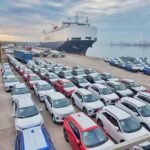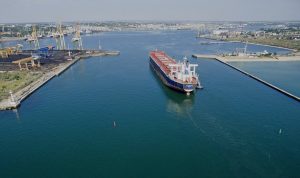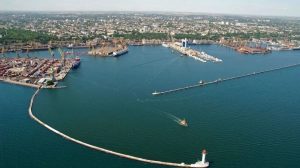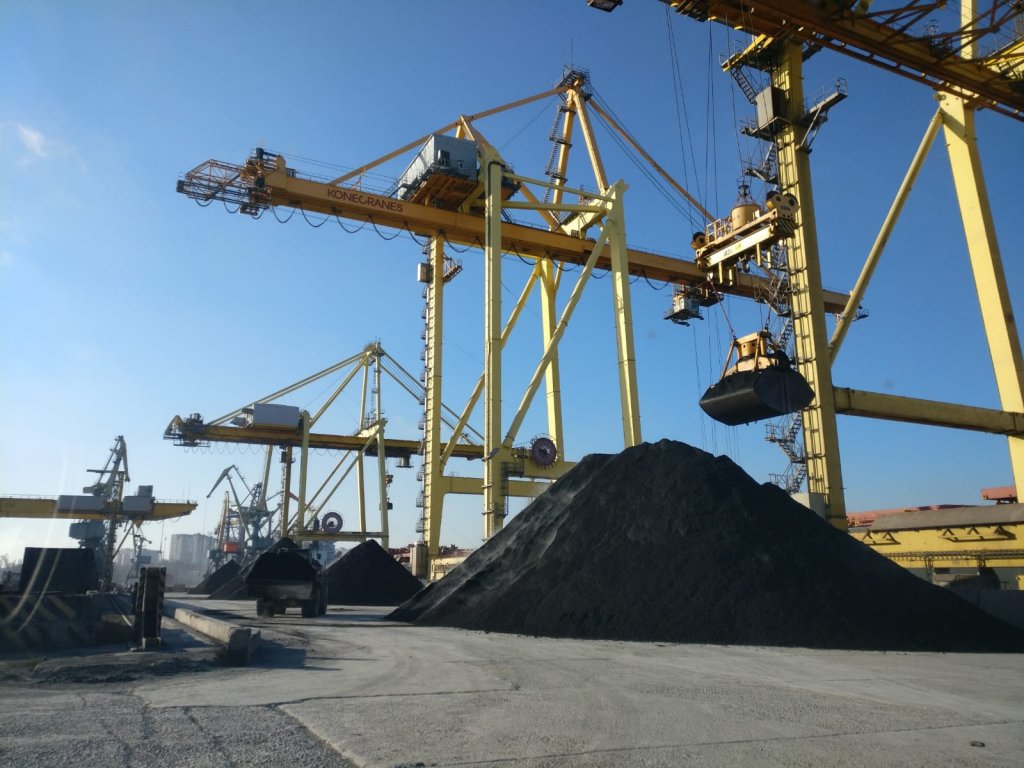Transport collapse in the port of Chornomorsk: what does customs have to do with it?
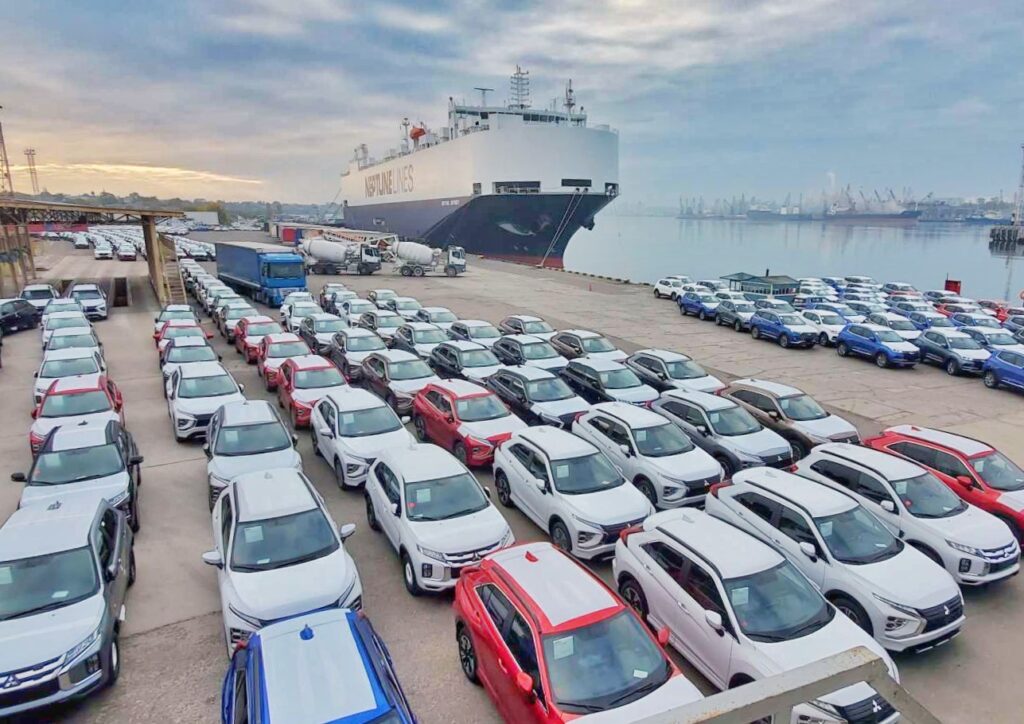
The State Enterprise “Commercial Seaport Chornomorsk” will increase the cost of unloading cars from vessels several times. However, is this really a problem, compared to the overpacking of the ferry complex’s warehouse? And should car buyers panic?
Starting from January 10th, the cost of loading and unloading cars at the Ferry complex in Chornomorsk has increased from $18.8 to $47 per unit (excluding VAT). And together with the tax, the amount for unloading one car is now $56.4.
The Director General of the All-Ukrainian Association of Automobile Importers and Dealers, Oleg Nazarenko, believes that the increase will affect the end customer, as individual companies can take advantage of the rise in the cost of the service to increase the price of a car.
USM found out the reasons for the price increase, and what really affects the final cost of cars.
According to Nazarenko, the increase in the cost of unloading a car is unreasonable, since “the unloading is that the port employee gets into the car and drives off 20 meters from the ferry.”
But in reality, the situation is a little more complicated, and the process of handling the car is not limited to “20 meters”: the car is driven first to the pier, and then to the port warehouse. They try to handle the cars as quickly as possible to avoid demurrage of a vessel, observing all safety measures.
Now about the amounts. The increase in the THC (Terminal Handling Charge) occurred from $18.8 to $47 (excluding VAT), that is, by $28.2 without VAT or $33.84 with VAT. The average cost of one new car is about $20,000 and more, a used one is about $3-5,000. Compared to the cost of the cargo itself, in most cases, at the new tariff, the client will pay less than 1% of the cost of a used car (this is without taking into account the cost of delivery and customs payments, that is, in reality – less than 0.5% of the final cost, and for new cars – even 0.016%.Therefore, to put it mildly, it is inappropriate to raise the question that the cost of the new Land Cruiser 300 will increase by “whopping” $33.
The transshipment tariff has not been changed for a long time (literally – for a decade), and this is even with dollar inflation. Compared to other ports, rates after the rise are within the market. For example, in Shanghai, China, the THC is about $60 per car, in Piraeus, Greece, about $53.
In other words, now the price increase is bringing the price of the service in line with the market and the associated labor costs. By the way, the average salaries of dockers in Greece and Turkey are no higher than Ukrainian ones.
The decision to increase the THC may cause customers to look towards other terminals, since the experience of transshipment of cars from containers is widely used at container terminals, and car handling operations can be carried out there. However, the cost of organizing such operations will be comparable to the rates set at the ferry complex. Moreover, the ferry complex is specialized, but is not a monopoly in this market: cars can be handled wherever there is a berth and platform.
Of course, global autobrands are used to the fact that the cost of THC and forwarding was extremely low, and the existing increase leads to an increase in the forwarding rate for them by almost 2 times.
At the same time, the above mentioned arguments suggest that it is quite possible to support the Ukrainian state-owned enterprise, which for the first time in a long time decided to raise tariffs. Moreover, in the amount of less than two tenths of a percent of the cost of the cheapest car.
The commercial seaport of Chornomorsk itself is in a state of crisis. Maintenance of ferries with cars is one of the main cargoes of the port. An increase in the tariff for unloading vehicles will not only improve the position of the enterprise, but also make it more attractive for the upcoming concession.
Customs clearance
After the autumn scandal with the overvaluation scheme through the Carstat website, statements to the State Bureau of Investigation, as well as further proceedings, the customs set indicative prices for Korean cars.
The creation of a civilized customs clearance process is certainly a boon. However, the excess happened in the direction of price increases. Of course, now no one can reproach the customs service for the fact that somewhere customs clearance is carried out according to the “scheme” and with an underestimation of the customs value. But, according to the import market participants, this indicator exceeds the real prices with delivery by $1-3 thousand, depending on the model and year of manufacture. And this already significantly affects the price, adding from $500 to $1500 to the cost of a car, or 15-30% of the cost.
Even now, the number of cars shipped from Korea has decreased by 50%. If more than 1,400 cars were delivered on the Young Shin car carrier, which is now in the roads of Chornomorsk, then only 700 were shipped to the next one. What is the reason?
The cars that came to the port now, were shipped in mid-December. These are the cars, the purchase decision of which was made at the end of November-beginning of December, when there were no inflated indicative prices yet. Since the end of December, car importers have been simply fulfilling the orders of their customers, and not taking on new ones. There may already be less than 500 of these cars for the February shipment.
Regarding this situation, the new Acting Director of commercial seaport Chernomorsk Vyacheslav Voloshin has already sent an appeal to the Head of customs Vyacheslav Demchenko: he asks to take measures to set the fair cost of customs clearance of cars from Korea.
In the letter, the Head of the port notes that cars from Korea began to pass through a specialized ferry complex since last autumn, and the prospective volume of this cargo traffic is 15,000 units per year.
“However, at the moment there is a stockpiling of the warehouse, which may lead to the impossibility of accepting and unloading vessels according to the previously declared volumes. According to the port’s customers, the delays in the release of the warehouse in the port are related to the issue of establishing indicative prices for cars imported from Korea, which, according to customers, are overpriced by an average of $2,000 per car. This leads to losses for auto traders and logistics companies that deliver these cars,” Voloshin explained.
According to the Head of the port, the cessation of this cargo flow due to overestimated indicators may lead to a loss of income by the port in the amount of more than UAH 25 million (USD 866.5 thousand), and the state budget arrears with VAT may amount to more than UAH 5 million (USD 173.3 thousand).


Transshipment of Korean cars on a direct monthly service is not only additional vessel calls and USPA revenues, but also port revenues from transshipment. And the situation with the stockpiling of the warehouse with used cars generally jeopardizes the further operation of the port and the reception of ships. At the moment, there are about 1,200 used cars from Korea in the warehouse, and the port expects another 1,400 in a few days. In total, there are 2,600 cars in the port (and this is only used ones from Korea), in total there are about 4,000 places in the warehouse. Therefore, the concern of the state-owned enterprise with the current situation is quite justified.
The editors also have at their disposal a letter from one of the largest Korean car exporters – DongBook. The company even reveals its car prices as an illustration of how much they are below benchmarks. At the same time, the exporter also addresses the Ukrainian Prime Minister Denys Shmyhal and the Embassy of the Republic of South Korea.


A similar letter addressed to the Prime Minister, the Head of customs and the Korean Embassy was written by another car exporter from Korea, KCM Trade. The company also called for a review of indicative prices for customs clearance of cargo.
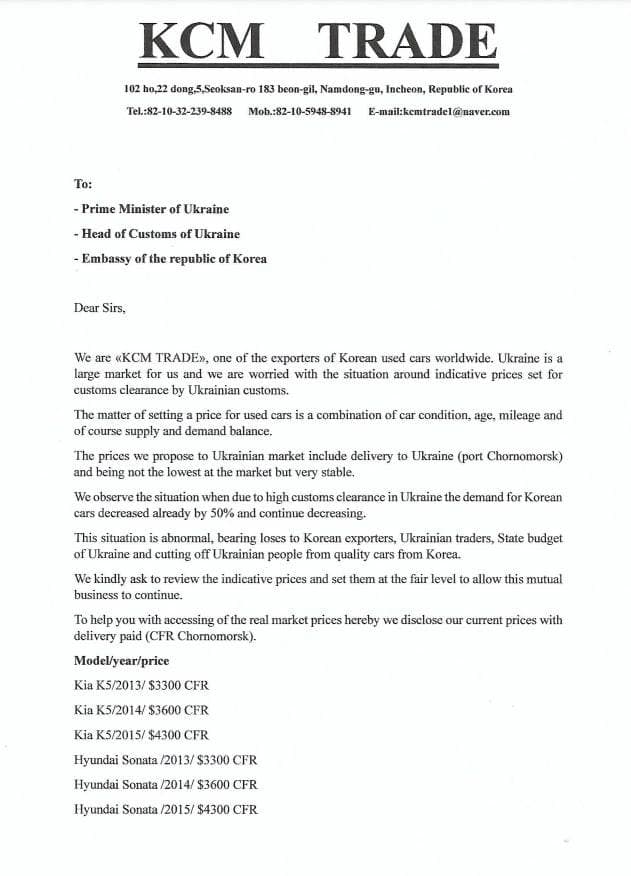
Transport collapse in the port of Chornomorsk: what does customs have to do with it?
JANUARY, 25TH, 2022 – 13:00
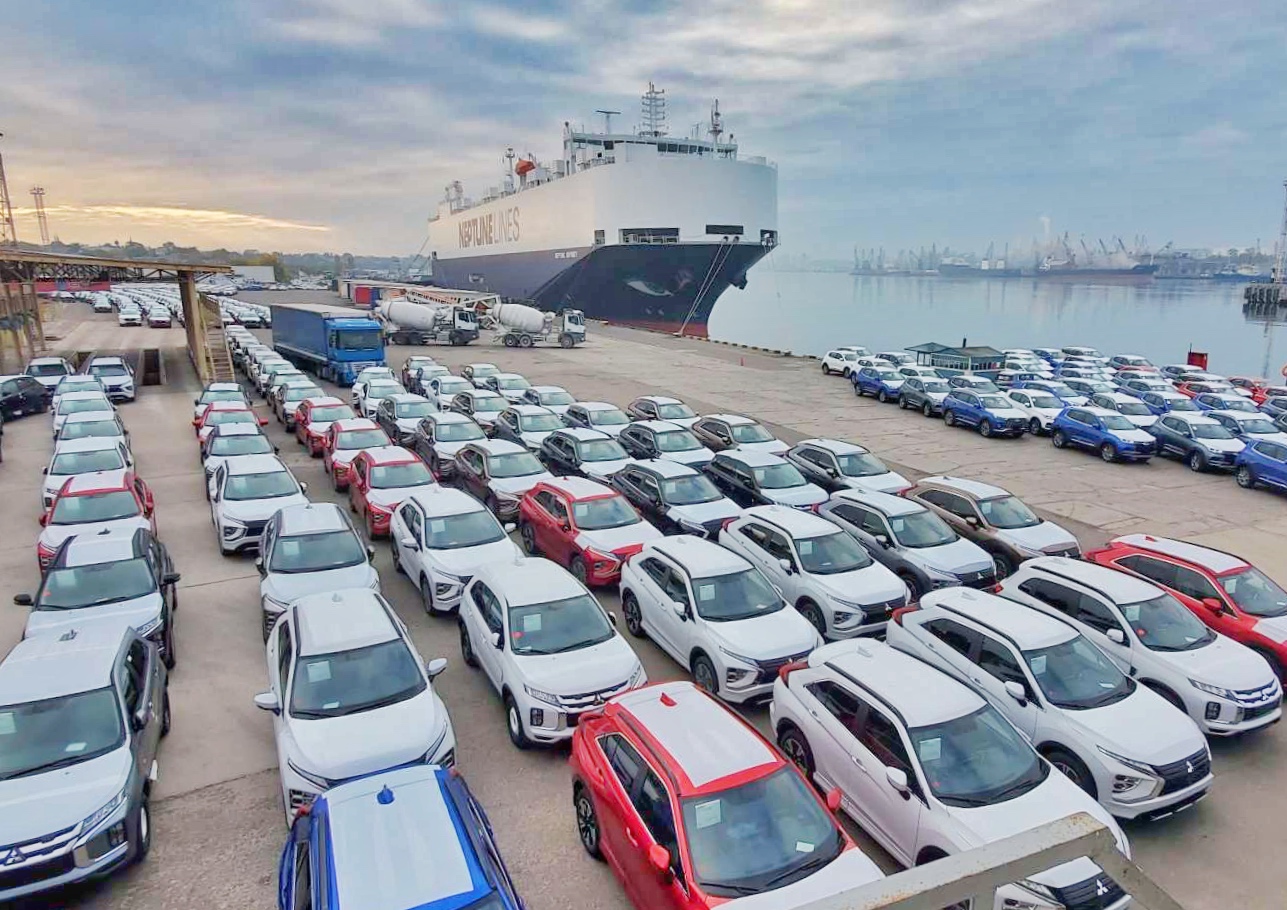
The State Enterprise “Commercial Seaport Chornomorsk” will increase the cost of unloading cars from vessels several times. However, is this really a problem, compared to the overpacking of the ferry complex’s warehouse? And should car buyers panic?
Starting from January 10th, the cost of loading and unloading cars at the Ferry complex in Chornomorsk has increased from $18.8 to $47 per unit (excluding VAT). And together with the tax, the amount for unloading one car is now $56.4.
The Director General of the All-Ukrainian Association of Automobile Importers and Dealers, Oleg Nazarenko, believes that the increase will affect the end customer, as individual companies can take advantage of the rise in the cost of the service to increase the price of a car.
USM found out the reasons for the price increase, and what really affects the final cost of cars.
According to Nazarenko, the increase in the cost of unloading a car is unreasonable, since “the unloading is that the port employee gets into the car and drives off 20 meters from the ferry.”
But in reality, the situation is a little more complicated, and the process of handling the car is not limited to “20 meters”: the car is driven first to the pier, and then to the port warehouse. They try to handle the cars as quickly as possible to avoid demurrage of a vessel, observing all safety measures.
Now about the amounts. The increase in the THC (Terminal Handling Charge) occurred from $18.8 to $47 (excluding VAT), that is, by $28.2 without VAT or $33.84 with VAT. The average cost of one new car is about $20,000 and more, a used one is about $3-5,000. Compared to the cost of the cargo itself, in most cases, at the new tariff, the client will pay less than 1% of the cost of a used car (this is without taking into account the cost of delivery and customs payments, that is, in reality – less than 0.5% of the final cost, and for new cars – even 0.016%.Therefore, to put it mildly, it is inappropriate to raise the question that the cost of the new Land Cruiser 300 will increase by “whopping” $33.
The transshipment tariff has not been changed for a long time (literally – for a decade), and this is even with dollar inflation. Compared to other ports, rates after the rise are within the market. For example, in Shanghai, China, the THC is about $60 per car, in Piraeus, Greece, about $53.
In other words, now the price increase is bringing the price of the service in line with the market and the associated labor costs. By the way, the average salaries of dockers in Greece and Turkey are no higher than Ukrainian ones.
The decision to increase the THC may cause customers to look towards other terminals, since the experience of transshipment of cars from containers is widely used at container terminals, and car handling operations can be carried out there. However, the cost of organizing such operations will be comparable to the rates set at the ferry complex. Moreover, the ferry complex is specialized, but is not a monopoly in this market: cars can be handled wherever there is a berth and platform.
Of course, global autobrands are used to the fact that the cost of THC and forwarding was extremely low, and the existing increase leads to an increase in the forwarding rate for them by almost 2 times.
At the same time, the above mentioned arguments suggest that it is quite possible to support the Ukrainian state-owned enterprise, which for the first time in a long time decided to raise tariffs. Moreover, in the amount of less than two tenths of a percent of the cost of the cheapest car.
The commercial seaport of Chornomorsk itself is in a state of crisis. Maintenance of ferries with cars is one of the main cargoes of the port. An increase in the tariff for unloading vehicles will not only improve the position of the enterprise, but also make it more attractive for the upcoming concession.
Customs clearance
After the autumn scandal with the overvaluation scheme through the Carstat website, statements to the State Bureau of Investigation, as well as further proceedings, the customs set indicative prices for Korean cars.
The creation of a civilized customs clearance process is certainly a boon. However, the excess happened in the direction of price increases. Of course, now no one can reproach the customs service for the fact that somewhere customs clearance is carried out according to the “scheme” and with an underestimation of the customs value. But, according to the import market participants, this indicator exceeds the real prices with delivery by $1-3 thousand, depending on the model and year of manufacture. And this already significantly affects the price, adding from $500 to $1500 to the cost of a car, or 15-30% of the cost.
Even now, the number of cars shipped from Korea has decreased by 50%. If more than 1,400 cars were delivered on the Young Shin car carrier, which is now in the roads of Chornomorsk, then only 700 were shipped to the next one. What is the reason?
The cars that came to the port now, were shipped in mid-December. These are the cars, the purchase decision of which was made at the end of November-beginning of December, when there were no inflated indicative prices yet. Since the end of December, car importers have been simply fulfilling the orders of their customers, and not taking on new ones. There may already be less than 500 of these cars for the February shipment.
Regarding this situation, the new Acting Director of commercial seaport Chernomorsk Vyacheslav Voloshin has already sent an appeal to the Head of customs Vyacheslav Demchenko: he asks to take measures to set the fair cost of customs clearance of cars from Korea.
In the letter, the Head of the port notes that cars from Korea began to pass through a specialized ferry complex since last autumn, and the prospective volume of this cargo traffic is 15,000 units per year.
“However, at the moment there is a stockpiling of the warehouse, which may lead to the impossibility of accepting and unloading vessels according to the previously declared volumes. According to the port’s customers, the delays in the release of the warehouse in the port are related to the issue of establishing indicative prices for cars imported from Korea, which, according to customers, are overpriced by an average of $2,000 per car. This leads to losses for auto traders and logistics companies that deliver these cars,” Voloshin explained.
According to the Head of the port, the cessation of this cargo flow due to overestimated indicators may lead to a loss of income by the port in the amount of more than UAH 25 million (USD 866.5 thousand), and the state budget arrears with VAT may amount to more than UAH 5 million (USD 173.3 thousand).


Transshipment of Korean cars on a direct monthly service is not only additional vessel calls and USPA revenues, but also port revenues from transshipment. And the situation with the stockpiling of the warehouse with used cars generally jeopardizes the further operation of the port and the reception of ships. At the moment, there are about 1,200 used cars from Korea in the warehouse, and the port expects another 1,400 in a few days. In total, there are 2,600 cars in the port (and this is only used ones from Korea), in total there are about 4,000 places in the warehouse. Therefore, the concern of the state-owned enterprise with the current situation is quite justified.
The editors also have at their disposal a letter from one of the largest Korean car exporters – DongBook. The company even reveals its car prices as an illustration of how much they are below benchmarks. At the same time, the exporter also addresses the Ukrainian Prime Minister Denys Shmyhal and the Embassy of the Republic of South Korea.


A similar letter addressed to the Prime Minister, the Head of customs and the Korean Embassy was written by another car exporter from Korea, KCM Trade. The company also called for a review of indicative prices for customs clearance of cargo.

Hereunder, USM lists prices for the same car models (including delivery) from DongBook and KCM Trade. In the table you can see how the prices of traders differ from the customs indicators.
These indicators are provided for USM by brokerage market participants.
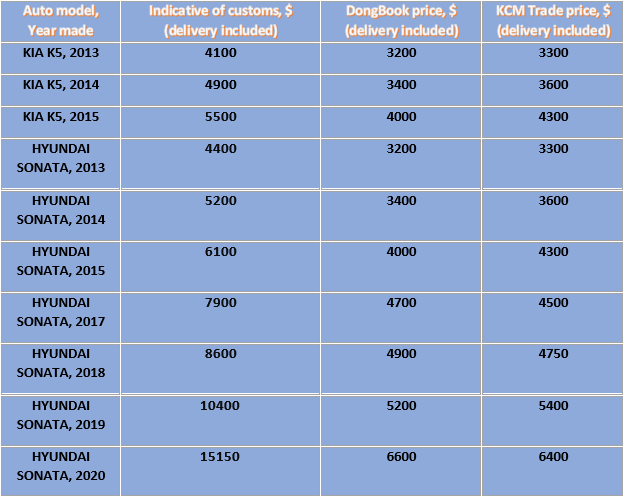
As a result, the final cost of the car is affected not by the port tariff for unloading, but by the indicator for customs clearance. And if Korean exporters have already turned to the Ukrainian authorities, it means that the situation is really serious.
Ukraine is not such a rich country that all its citizens could afford new cars. In addition, transshipment of cars is, among other things, a major source of income for the port itself. Therefore, one can only hope that the customs will take immediate and fair measures to resolve the situation. Then there is a chance that Korean imports will not stop, Ukrainians will not lose the opportunity to buy Korean cars, the state budget will not stop filling up with payments from the fair price of cars, and the state port will continue to receive revenue from transshipment.
Olha Horbenko.
